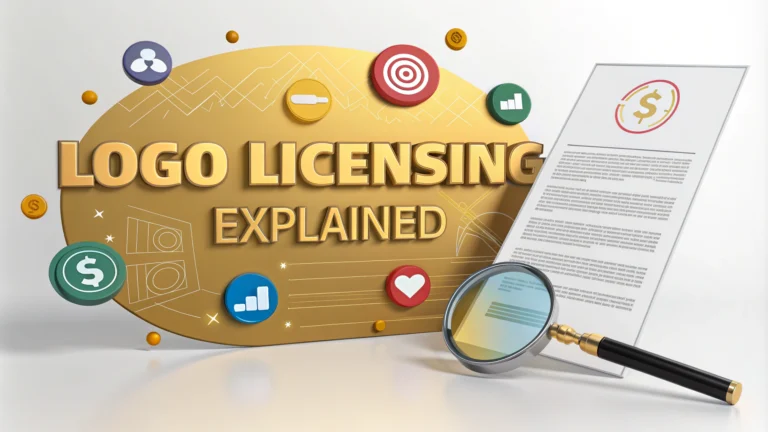Logo licensing protects both designers and clients by establishing clear terms for how a logo can be used.
A logo license agreement outlines who owns the logo’s intellectual property rights and how the logo may be used commercially.
Types of Logo Licenses
- Exclusive License: Gives the client sole rights to use the logo
- Non-exclusive License: Allows multiple parties to use the same logo
- Limited License: Restricts usage to specific products, territories, or time periods
Key Elements of Logo Licensing
Every logo license should include these essential components:
- Usage rights and limitations
- Geographic restrictions
- Duration of the license
- Modification permissions
- Transfer rights
- Payment terms
Common License Restrictions
| Restriction Type | Description |
|---|---|
| Territorial | Limits logo use to specific geographic areas |
| Time-based | Sets specific duration for logo usage |
| Industry-specific | Restricts use to certain business sectors |
Pricing Considerations
Logo licensing fees typically depend on these factors:
- Scope of usage rights
- Geographic coverage
- License duration
- Industry exclusivity
- Company size and reach
Legal Protection Tips
- Register your logo with the USPTO (www.uspto.gov)
- Document all logo usage agreements in writing
- Include clear termination clauses
- Specify approved logo variations
- Define quality control measures
Red Flags to Watch For
- Unclear ownership terms
- Missing usage restrictions
- Vague termination clauses
- Undefined geographic scope
- Absent quality control provisions
Contact a qualified intellectual property attorney for specific legal advice about logo licensing.
For additional resources on logo licensing, visit the International Trademark Association (www.inta.org).
Additional License Considerations
Logo Modifications
- Color variations permitted
- Size adjustment guidelines
- Format requirements
- Approved background usage
Sublicensing Rights
Clearly define whether the licensee can grant rights to third parties and under what conditions.
Quality Control Measures
- Regular logo usage audits
- Approval process for new applications
- Brand guideline compliance
- Reporting requirements
Enforcement Procedures
| Violation Type | Recommended Action |
|---|---|
| Unauthorized Use | Cease and desist letter |
| Quality Standards | Written warning and correction period |
| Payment Default | License suspension |
Conclusion
Effective logo licensing requires careful attention to detail and clear documentation of all terms and conditions. Proper licensing protects both parties’ interests and maintains brand integrity. Regular review and updates of licensing agreements ensure continued relevance and legal compliance.
Key takeaways:
- Document all agreements thoroughly
- Include specific usage parameters
- Maintain regular quality control
- Establish clear enforcement procedures
- Review and update agreements periodically
FAQs
- What is logo licensing and why is it important?
Logo licensing is the legal agreement that defines how and where a logo can be used. It’s crucial because it protects the intellectual property rights of the designer and establishes clear terms for the client’s usage of the logo. - What’s the difference between exclusive and non-exclusive logo licensing?
Exclusive licensing means the logo is sold to only one client who gets full rights to use it. Non-exclusive licensing allows the same logo to be sold to multiple clients, often at a lower cost. - Do I automatically own the copyright when I pay for a logo design?
No, paying for a logo design doesn’t automatically transfer copyright ownership. Unless specifically stated in the contract with a copyright transfer agreement, the designer retains the copyright while the client receives a license to use the logo. - What’s typically included in a logo licensing agreement?
A logo licensing agreement typically includes usage rights, territories where the logo can be used, duration of the license, modification rights, termination conditions, and any restrictions on usage. - How long does a logo license typically last?
Logo licenses can be perpetual (forever) or time-limited. The duration should be clearly specified in the licensing agreement, with perpetual licenses being more common for business logos. - Can I modify a licensed logo?
Modification rights depend on the specific terms in your licensing agreement. Many licenses restrict modifications to preserve the logo’s integrity, requiring designer approval for any changes. - What happens if I use a logo outside its licensing terms?
Using a logo outside its licensing terms constitutes copyright infringement, which can result in legal action, fines, and the requirement to cease using the logo immediately. - Is logo licensing different for digital and print usage?
Yes, licensing terms often specify different rights for digital and print usage. Some licenses may restrict certain mediums or require additional fees for expanded usage rights. - What’s the difference between logo licensing and logo ownership?
Logo licensing grants permission to use the logo under specific terms, while ownership (copyright) includes all rights to the logo, including the right to sell, modify, and license it to others. - How are logo licensing fees typically structured?
Logo licensing fees can be one-time payments for perpetual use, annual fees, royalty-based payments, or tiered pricing based on usage scope and exclusivity levels.







